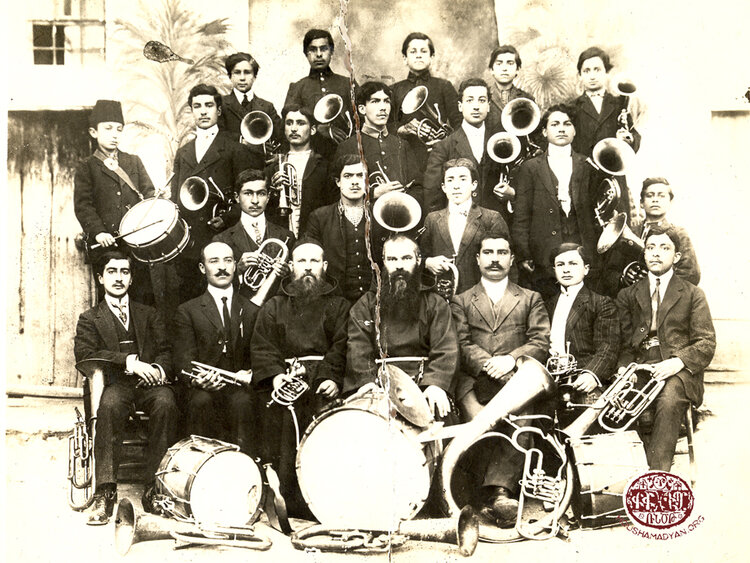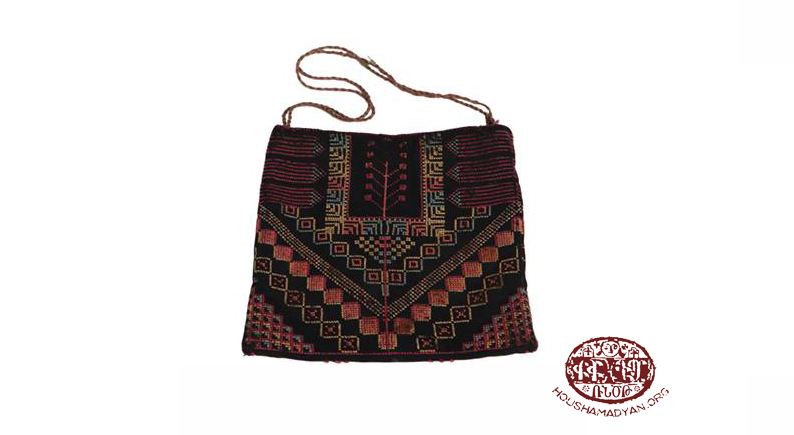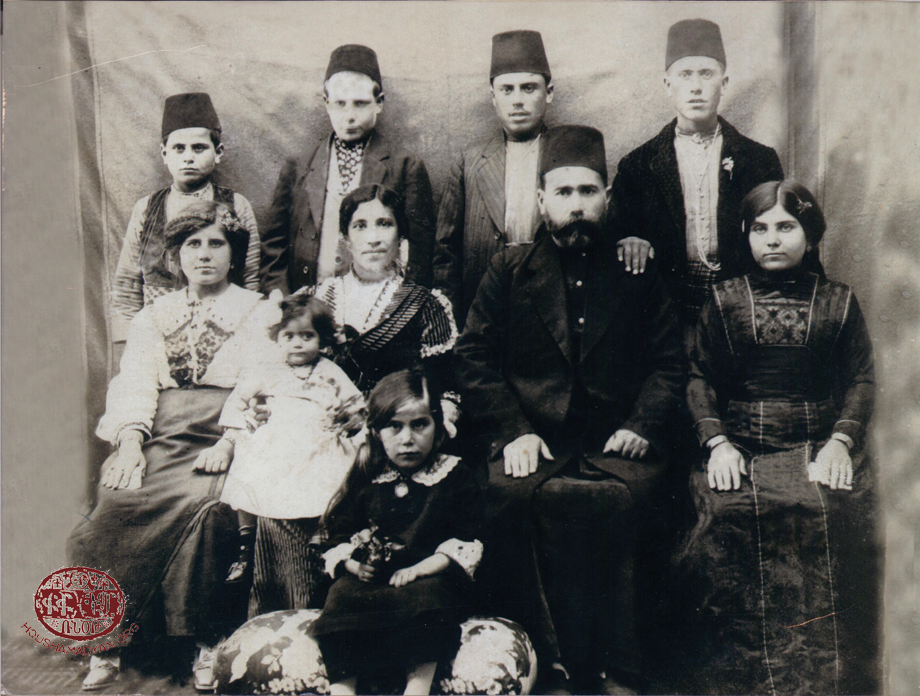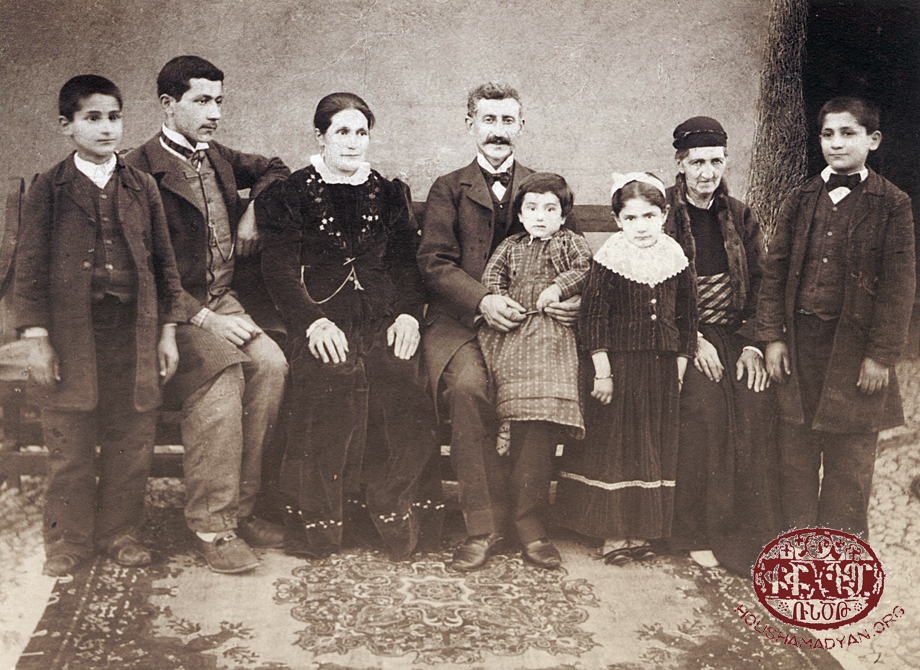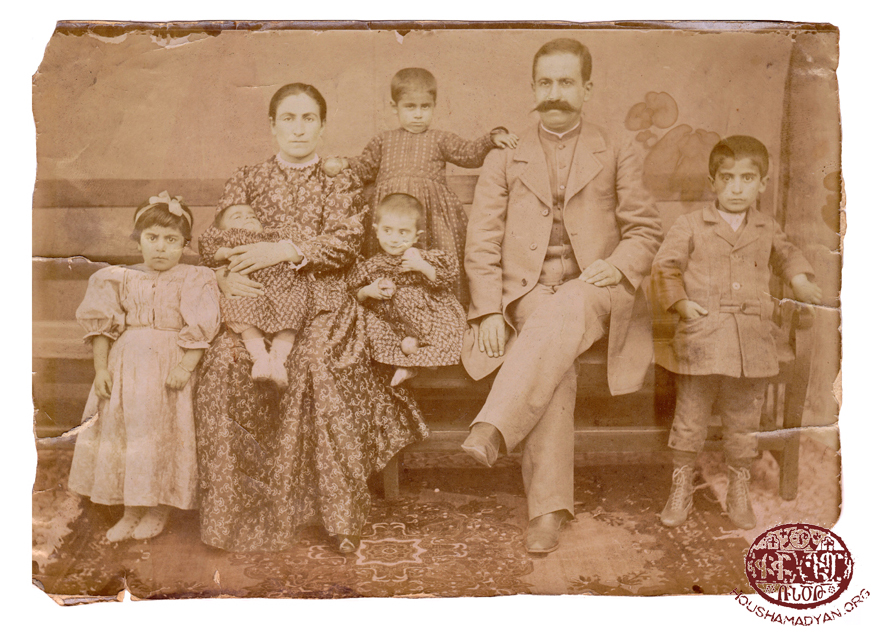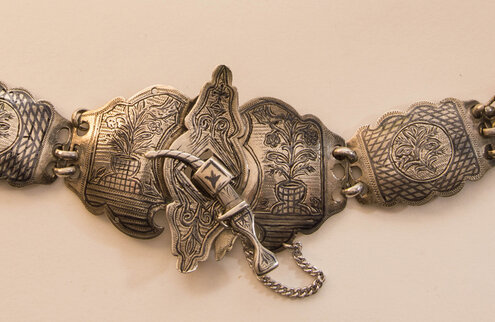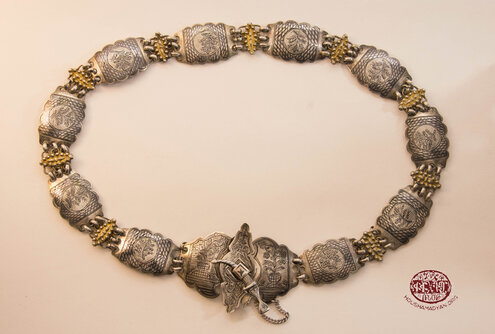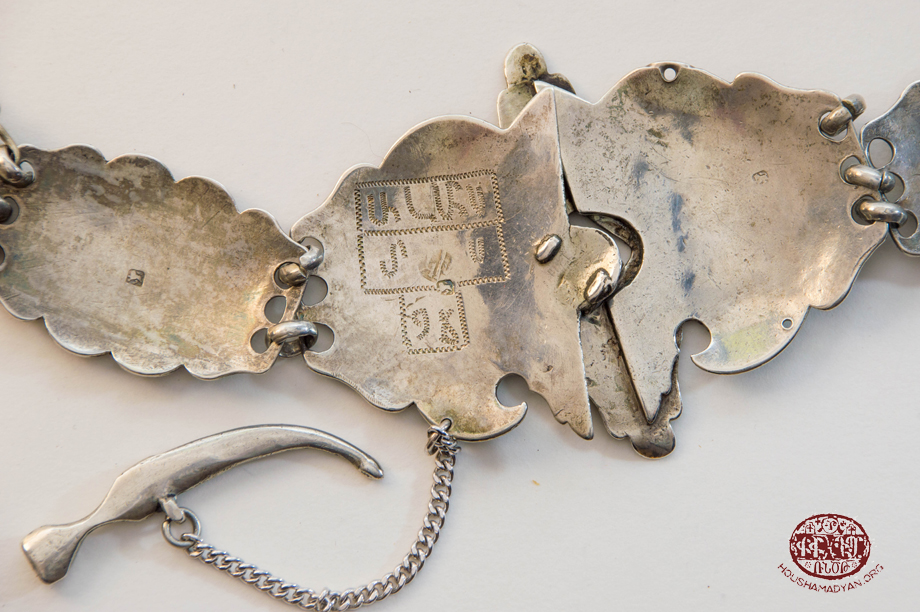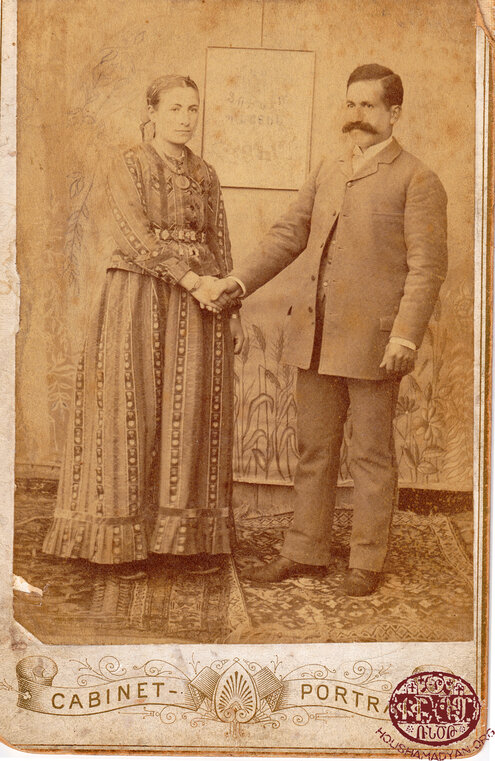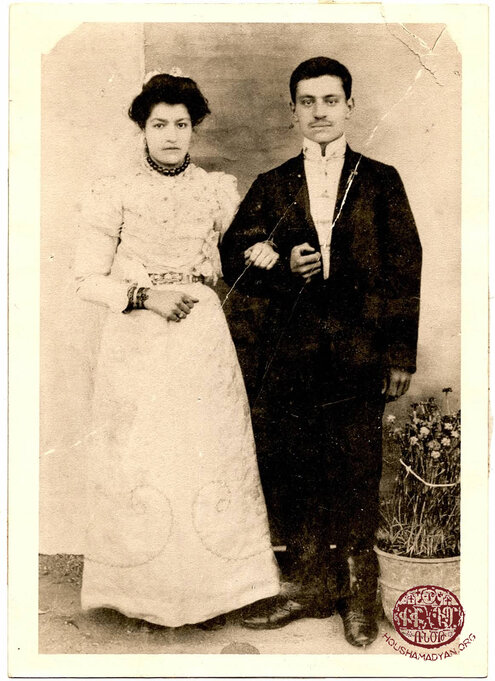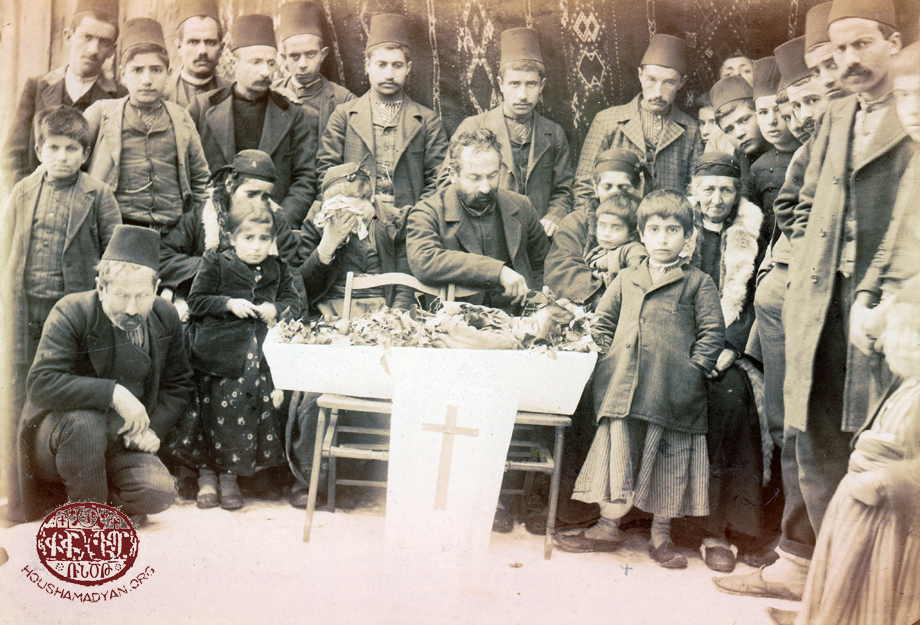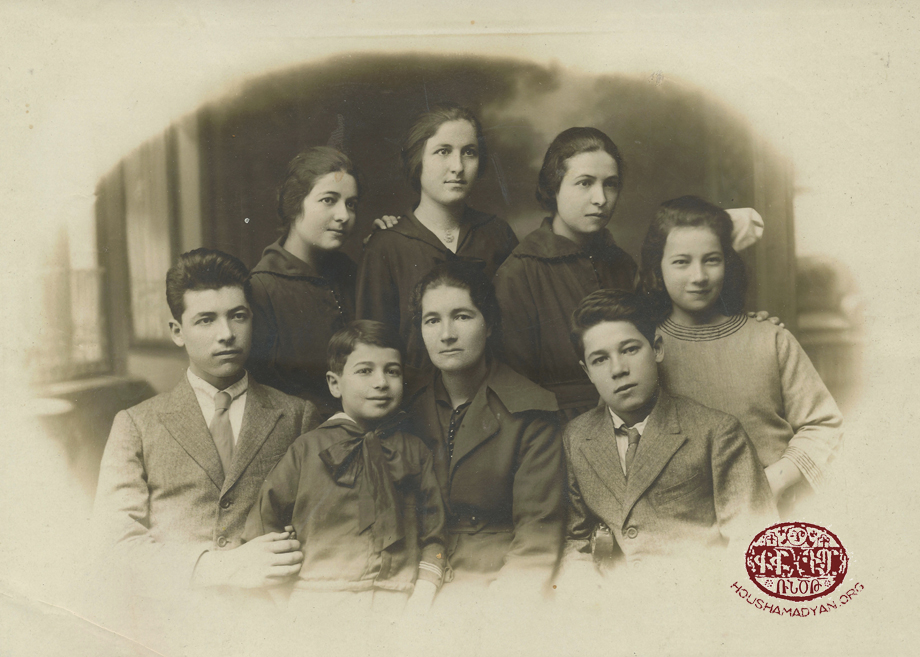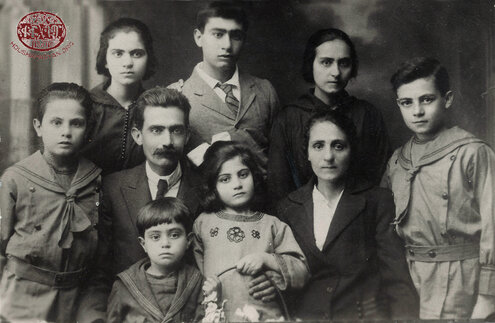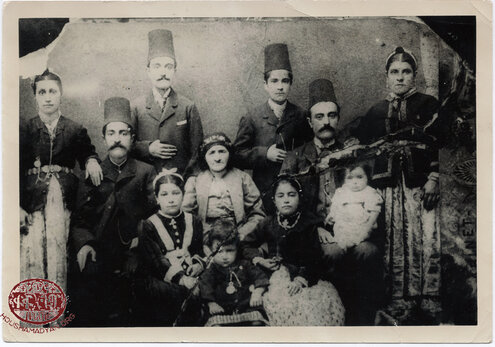Miscellaneous - USA
Tenjoukian Collection - San Francisco
Woman’s bag: Tarsus, 22cm x 20.5cm
It belonged to Bahar Torosian from Tarsus. In the early 1920’s the Armenians of Cilicia were forced to leave their native villages and towns and Bahar, like many others, resettled in Lebanon. There, the bag was passed down to Bahar’s daughter Shakeh (1920-2003) who continued to use it. Today, the bag is in the keeping of Bahar’s great-granddaughter Nany Tenjoukian in San Francisco.
Aleppo. The family of Hadji Haroutyun (Artin) Agha and Eliza Torosian (from Biredjik/Birecik), ca. 1918. Standing (from left): Hagop ('Djaneh'), Mihran, Khachig, and Dikran. Seated (from left: Roza, Eliza, Azaduhie (seated in her mother's lap), Haroutyun, and Mariam. The girl seated on a pilow is Hripsimeh. Little Azaduhie was the first child of Haroutyun and Eliza. Eliza (born Kalemkerian) was from Ayntab. She met Haroutyun in Aleppo during the exile years 1915-1918. The other individuals in the photo are the children of Osanna, Haroutyun's first wife, who died in 1910 (Nany Tenjoukian collection, San Francisco)
Chuck Kurkjian collection - USA
This family portrait, taken in the City of Agn/Eğin (modern-day Kemaliye) was sent to Houshamadyan by Chuck Kurkjian. After 1915, the survivors of the family immigrated to the United States. With them, they brought a rug, which, to this day, is kept by Chuck Kurkjian.
Agn/Eğin, circa 1905, the Kurkjian family. The older couple in the center are the mother and father of the family (names unknown), and they are surrounded by their children. From left to right: John (born in 1892, Chuck’s father); Harry/Hovhanness (born in 1888); Alex, sitting in his father’s lap; Zvart; the children’s grandmother (probably on the material side); and Levon. John and Harry were the only two to survive the Genocide.
Rug, Agn, 150 cm x 94 cm
It is believed that this rug was woven by Armenian orphans in Agn. We know that during the 1895 Hamidian Massacres, many Armenians in Agn were killed, and a number of Armenian children were left orphaned. Like in many other parts of the Ottoman Empire, orphanages were established, where these orphans were raised and taught crafts. Selling rugs woven by these orphans overseas was an important source of income for these institutions. Most probably, this rug, too, was meant to be sold overseas. It later found its way into the hands of Harry/Hovhanness Kurkjian, Chuck Kurkjian’s uncle. Currently, the rug is in Chuck’s possession. The inscription on the rug, partially in Armenian, and partially in English, reads “The orphans of Agn1898 July 4.”
Kaboulian collection - USA
These materials, and the information that accompanies them, were sent to us by descendants of the Kaboulian/Kaboolian family, including Diane Kaboolian, Carolanne Najarian, and Linda Kaboolian. The family’s origins lie in Agn/Eğin. Diane’s father was Haygaz Kaboulian, who was the son of Boghos Kaboulian (from Agn) and Rebecca Demirjian (from Harput/Kharpert).
The Kaboulian family, Agn, ca 1906. From left to right, Varsenig, Rebecca (nee Demirdjian born in Harput/Kharpert), Eliz (baby, in her mother’s lap), Karekin (standing between Rebecca and Boghos), Haigaz (in front of Karekin), Boghos, and Gabriel (Source: Haigaz and Ute Kaboolian collection)
After the above photograph was taken, Boghos and Rebecca Kaboulian hat three more children – Virginia, Onnig, and Aram. After the First World War, Virginia and Elise were taken into an orphanage, while Onnig lived with Kurdish tribes for some time. Boghos, Gabriel, and Aram fell victim to the Genocide. As for the members of the family who survived, they lived for a while in Aleppo, then migrated to the United States.
Silver bridal belt, from Agn. The belt once belonged to Almas (Kegham Kaboulian’s mother and Boghos Kaboulian’s sister-in-law). After Almas’s death, the belt was passed on to her daughter-in-law Rosa (Kegham’s wife), who later brought it with her all the way to the United States. The belt was made in Van, and sports two maker’s marks, one being the image of a lion, which means the belt was the work of master craftsman Arslanian, and the engraved letters “G” and “T,” which attest to the fact that a second craftsman also worked on it. The name Almas is also engraved on the surface of the belt, as well as the number 98. It is plausible that the belt was made in 1898 (we thank Osep Tokat for providing information related to the belt’s provenance). Today, the belt is kept as a family heirloom in the United States.
1) Wedding photograph of Boghos Kaboulian and Rebecca Najarian.
2) Wedding photograph of Rosa Masoumian and Kegham Kaboulian, Carolanne Najarian’s grandparents. The photograph was taken in Arapgir, circa 1910. Kegham was Boghos Kaboulian’s nephew, and his father had died at a young age. Around 1912-1913 Kegham immigrated to the United States. His wife stayed behind in Agn, while his widowed mother Almas and Rosa moved to Palu, where Almas later died. During the Genocide, Rosa was deported all the way to deserts of Deir ez-Zor, and survived.
Burial photograph from Agn, circa 1910. The dead child was Boghos and Rebecca Kaboulian’s five-year-old son, Hovhanness. The bearded man seated right behind the coffin is Boghos Kaboulian, and on his left is Rebecca Kaboulian, covering her face with a handkerchief. At the feet of the deceased child is Varsenig (Boghos and Rebecca’s daughter), and the boy standing near the deceased’s head is Gabriel (Boghos and Rebecca’s son).
Susan Sobaje collection - Fresno CA
This collection contains photographs of an Armenian family originating from Harput/Kharpert. One of the branches of this family was led by Hovhanness Bujicanian (born in Chunkush in 1873), who was one of the renowned figures of Harput. He was a teacher at the Euphrates College in Harput, and was one of the town’s prominent intellectuals. He would become one of the first victims of the Armenian Genocide. In 1900, Hovhanness married Maritsa Tyufenkdjian. The couple had seven children – four daughters: Asdghig, Mary, Anahid, and Araksi; and three sons: Armen, Karekin, and Hagop. After the Genocide, Maritsa and her children fled to Lebanon. Anahid was the fifth of the couple’s children, born in 1912 in Harput. She too, lived in Lebanon, but later on in life, with the intention of pursuing higher education, she migrated to the United States, where, in 1951, in Fresno, California, she married Nathan Eliazarian. Nathan himself had been born in the Ichme/Içme village of the Harput Valley. This collection was sent to us by Anahid and Nathan’s daughter, Susan Sobaje.
1) This photograph shows the family of Hovhanness Bujicanian’s brother, Mardiros. He was a music teacher working in the area of Harput, and he had received his higher education in Germany. For many years he taught at the German College of Mezire (Mamuretul-Aziz), near Harput. He composed many songs, wrote lyrics, and translated several Protestant hymns to Armenian. During the years of the Genocide, thanks to the efforts of Johannes Ehmann (1870-1926), a German missionary who was active in the Harput area, Mardiros and his family, as well as the families of his two brothers and sister, were spared deportation. Later, Mardiros and his family migrated to the United States, where he died in 1935.
First row, left to right: Hayg; Mardiros (the father of the family); Daniel, sitting right in front of his father; Vartouhi, Shushan (nee Jamgochian, Mardiros’s wife). Back row, left to right: Verjin, Arsen, Varsenig, and Hagop.
2) The family of Maritsa Tyufenkdjian, wife of Hovhanness Bujicanian. Left to right, standing: Maritsa’s mother Hripsime; beside her, sitting, is Maritsa’s father Karekein. Maritsa (born in 1883) is sitting in front of her father, with a white ribbon in her hair. The Tyufenkdjians hailed from Harput, and this photograph was most probably taken in 1897.
